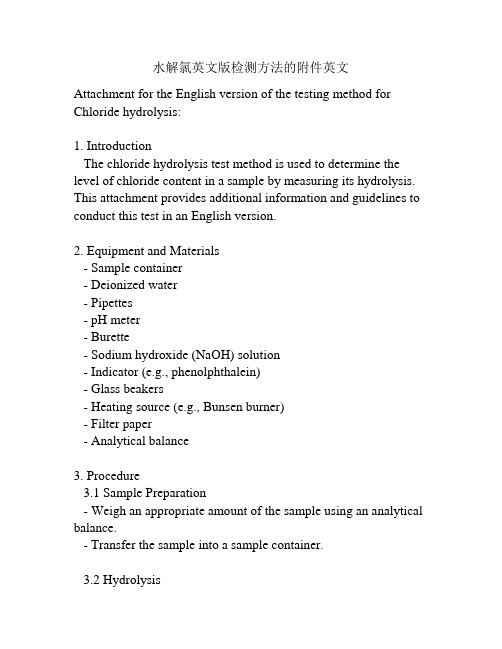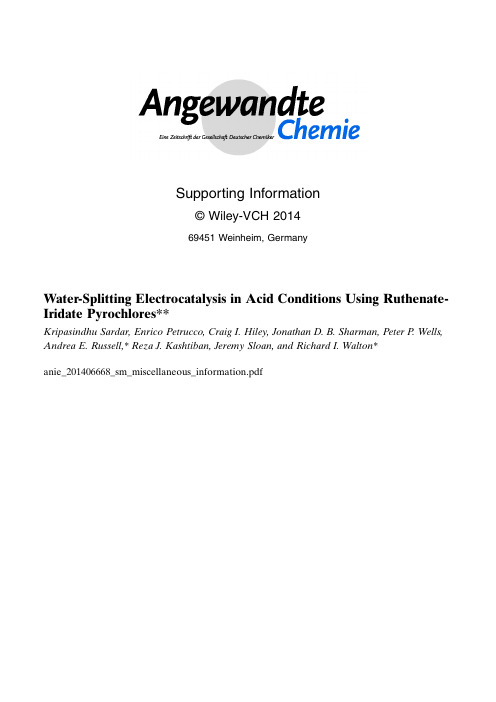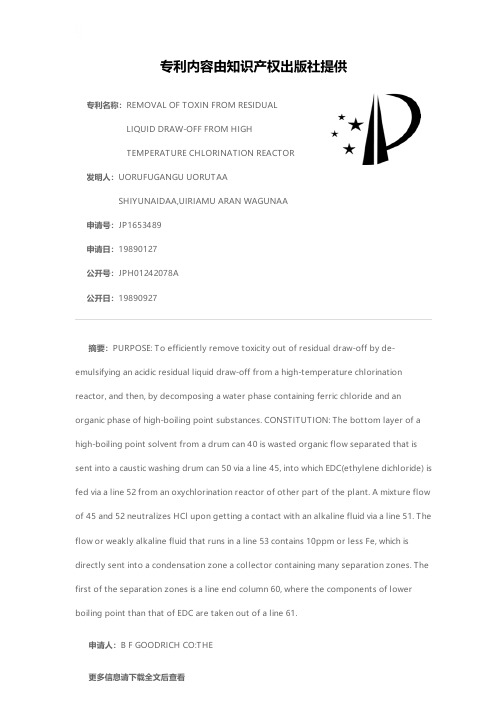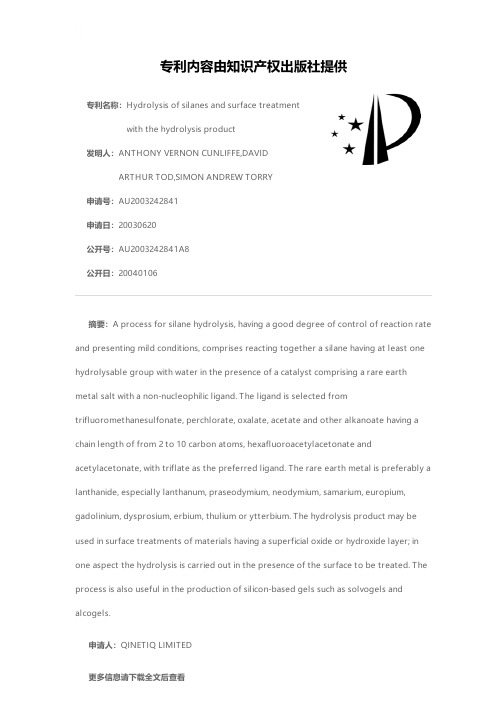R-_-_-Deprenyl_hydrochloride_LCMS_24919_MedChemExpress
水解氯英文版检测方法的附件英文

水解氯英文版检测方法的附件英文Attachment for the English version of the testing method for Chloride hydrolysis:1. IntroductionThe chloride hydrolysis test method is used to determine the level of chloride content in a sample by measuring its hydrolysis. This attachment provides additional information and guidelines to conduct this test in an English version.2. Equipment and Materials- Sample container- Deionized water- Pipettes- pH meter- Burette- Sodium hydroxide (NaOH) solution- Indicator (e.g., phenolphthalein)- Glass beakers- Heating source (e.g., Bunsen burner)- Filter paper- Analytical balance3. Procedure3.1 Sample Preparation- Weigh an appropriate amount of the sample using an analytical balance.- Transfer the sample into a sample container.3.2 Hydrolysis- Add deionized water to the sample container, ensuring that the sample is completely submerged.- Allow the sample to hydrolyze for a predetermined period (e.g., 24 hours) at room temperature.3.3 Measurement- Take a pH measurement of the hydrolyzed sample using a pH meter.- Record the pH value obtained.3.4 Titration- Transfer a known volume of the hydrolyzed sample (e.g., 50 mL) into a glass beaker.- Add a few drops of the indicator to the beaker.- Titrate the sample with sodium hydroxide solution until the pH reaches the desired endpoint (e.g., pH 8.3). Record the volume of NaOH solution used.4. Calculation- Calculate the chloride content in the sample using the volume of NaOH solution used, the concentration of the NaOH solution, and the initial mass of the sample.5. ReportingReport the chloride content of the sample in the appropriate unit (e.g., ppm) along with the testing conditions, including the sample preparation method, hydrolysis time, pH measurement, and titration procedure.Please note that this is a general guidance for the English versionof the testing method for chloride hydrolysis. Specific details and procedure may vary depending on the laboratory's protocols and requirements.。
Water-Splitting Electrocatalysis in Acid Conditions Using RuthenateIridate Pyrochlores-s

Figure
S1:
Refined
powder
XRD
patternsfor来自(a)(Na0.33Ce0.67)2(Ir)2O7
(b)
(Na0.33Ce0.67)2(Ir0.5Ru0.5)2O7 and (c) (Na0.33Ce0.67)2(Ru)2O7. In (a) * and # indicate small amounts of IrO2 and CeO2 impurity, respectively.
3
TGA/DSC (using a Mettler-Toledo TGA/DSC1 instrument) were recorded under a flow of air with a 10 °C min-1 heating rate. All show 5 % surface water/hydroxide mass loss to 600 ° C. The Ircontaining materials additionally show mass loss at >900 °C which corresponds to reduction to Ir metal; this generally increases with increasing Ir content in the series of materials (athough the mass loss is not always complete at 1000 °C.
4
Polarisation curves were obtained by logarithmically spaced galvanostatic steps with electrochemical impedance spectroscopy at each step. The EIS curves were fitted using a resistor, inductor, and Cole-element in series as the equivalent circuit using ZView. Exhaust gas was fed to a Spectra mass spectrometer and continuously monitored throughout the entire test protocol for oxygen evolution and carbon corrosion products from competing side reactions. Electrochemical work at Diamond Light Source used a Hg/Hg2SO4 (MMS) reference electrode in 0.5M H2SO4 which was calibrated against a hydrogen reference electrode off site at 0.68V vs RHE such that 1.00 V vs MMS signal was equivalent to 1.68 V vs RHE. Table S2 shows the mass activity and onset for oxygen evolution data collected during voltammetry. Also included in the table are the fit parameters found for data collected at 10 mA cm2 during polarisation. The parameters indicate DC resistance, R0, charge transfer resistance, Rct, capacitive time constant, τ, and phase, α.
中国林蛙皮肤丝氨酸蛋白酶抑制剂RCSPI2的基因克隆和原核表达

采用http:Hexpasy.org/tools/中的Gen03d软件对重组 蛋白RCSPl2的j级结构进行了预测,RCSPl2属于Kunitz 型抑制剂(图1),其三级结构和来自牛蜱的Kunitz型蛋白 酶抑制剂颇为相似,RCSPl2蛋白分子中n螺旋(H)、p折 叠(E)和无规则卷曲(L)所占比例分别为18.00%,20.00%, 62.oo%,其理论pI为8.23,Mw为35.32 kD。经过 http://www.ebi.ac.uk/Tools/InterProScan预测,结果显示 RCSPl2蛋白包含三个功能域Pl、P2和P3,分别位于第 27—79,83一14l,145一197氨基酸,和Kunitz BPTI极为 相似。它们都位于一个溶剂暴露的环上,其中Pl是抑制 作用的关键活性位点,其深深插入丝氨酸蛋白酶特异的 束缚“121袋”sl位置。对于胰蛋白酶,由于这个位置的Asp 残基在又窄又深的“口袋”底部,它独特的位置和方向格 外适合与Lys和Arg等碱性氨基酸残基作用l"l。经过 http://www.predictprotein.org/预测,RCSPl2分子内能形成 5对二硫键,分别是28—53、37—61、74—84、123一140、 17l—192。二硫键对Kunitz结构域的稳定至关重要,另外 Kunitz型家族都有很明确的B.折叠和C端旺.螺旋,使整 个分子变得更加紧凑、稳定。
REMOVAL OF TOXIN FROM RESIDUAL LIQUID DRAW-OFF FRO

专利名称:REMOVAL OF TOXIN FROM RESIDUAL LIQUID DRAW-OFF FROM HIGH TEMPERATURE CHLORINATION REACTOR
发明人:UORUFUGANGU UORUTAA SHIYUNAIDAA,UIRIAMU ARAN WAGUNAA
申请人:B F GOODRICH CO:THE
更多信息请下载全文后查看
申请号:J P 16534 89 申请日:19890127 公开号:J P H 0124 2078A 公开日:19890927
摘要:PURPOSE: To efficiently remove toxicity out of residual draw-off by deemulsifying an acidic residual liquid draw-off from a high-temperature chlorination reactor, and then, by decomposing a water phase containing ferric chloride and an organic phase of high-boiling point substances. CONSTITUTION: The bottom layer of a high-boiling point solvent from a drum can 40 is wasted organic flow separated that is sent into a caustic washing drum can 50 via a line 45, into which EDC(ethylene dichloride) is fed via a line 52 from an oxthe plant. A mixture flow of 45 and 52 neutralizes HCl upon getting a contact with an alkaline fluid via a line 51. The flow or weakly alkaline fluid that runs in a line 53 contains 10ppm or less Fe, which is directly sent into a condensation zone a collector containing many separation zones. The first of the separation zones is a line end column 60, where the components of lower boiling point than that of EDC are taken out of a line 61.
Hydrolysis of silanes and surface treatment with t

摘要:A process for silane hydrolysis, having a good degree of control of reaction rate and presenting mild conditions, comprises reacting together a silane having at least one hydrolysable group with water in the presence of a catalyst comprising a rare earth metal salt with a non-nucleophilic ligand. The ligand is selected from trifluoromethanesulfonate, perchlorate, oxalate, acetate and other alkanoate having a chain length of from 2 to 10 carbon atoms, hexafluoroacetylacetonate and acetylacetonate, with triflate as the preferred ligand. The rare earth metal is preferably a lanthanide, especially lanthanum, praseodymium, neodymium, samarium, europium, gadolinium, dysprosium, erbium, thulium or ytterbium. The hydrolysis product may be used in surface treatments of materials having a superficial oxide or hydroxide layer; in one aspect the hydrolysis is carried out in the presence of the surface to be treated. The process is also useful in the production of silicon-based gels such as solvogels and alcogels.
